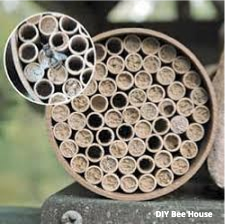By Jody Gardiner, Wild Ones Front Range chapter member
Join us in saving our bees and the world’s food supply, ONE YARD AT A TIME! Not all bees are alike. Most of us are familiar with honey bees. Less familiar to most of us are the cross-pollinating solitary (hive-less) native bees, like mason and leaf cutter bees, which power our gardens and farms, providing more food for more people.
One mason bee can pollinate an entire cherry tree. It requires 60 honey bees to pollinate that same tree!
How do they do it?
Pollination power!
Solitary bees belly-flop their dry hairy bodies onto flowers’ pollen and can carry loads of pollen which falls off at each flower. The honey bee, however, coats the pollen with saliva and prevents the pollen from transferring freely onto flowers.
How else are native bees different from honey bees?
- Unlike honey bees, solitary bees lay their young in found holes, not created hives. This makes them less territorial, more docile and easier to raise. They are also so fun to watch!
- Native bees don’t answer to a Queen bee. All females are egg-laying queens!
- “You won’t feel a thing, cause they ain’t got no sting”
- Male bees do not have stingers and females are not aggressive because they are just too busy!
- Native bees don’t induce anaphylactic shock and are safe around kids and pets.
- Solitary bees use mud or leaves to make their nests and require no special bee-keeping equipment.
- They emerge from their cocoons, find a mate, eat nectar for nourishment, then start building chambers from mud or leaves inside found holes.
Of the approximately 4,000 native bee species known to occur in the United States, 946 are found in Colorado (Colorado State University Extension).

What about wasps?
We have social wasps which include the annoying yellowjacket. Not a great pollinator. Feel free to trap these buggers. But we also have beneficial solitary pollinating wasps. Let them be. You can learn more about social wasps here.
What about a swarm of bees?
If you are ever so lucky to see a swarm, do not call a pest removal service. These are valuable honey bees. Do not hit it with a stick. Do not spray the swarm with anything. Enjoy the scene and hope that you get to see the entire swarm take flight. Beautiful. But keep watch. It may take the bees hours to collect together, but they will be gone in a minute when they get the word to head out. Or call the Colorado Bee Keepers Swarm hotline at 970-658-4949 and a dedicated, eager bee keeper will be at your home within a few hours.
How to provide a bee-friendly habitat and healthy sanctuary:
- Limit the use of chemicals, pesticides, herbicides, and liquid fertilizer.
- Plant native blossoming plants.
- Provide moist, clay mud
- Put up a bee house!
For more great information:
- Visit CrownBees.com
- Read Mason Bee Revolution: How the Hardest Working Bee Can Save The World One Backyard at a Time by Dave Hunter and Jill Lightner
- Consult CSU extension services on how to attract native bees in your landscape
- Join the Native Bee Network (NBN)
- Observe various bee houses at the Denver Botanic Gardens – or right here in your neighborhood!
